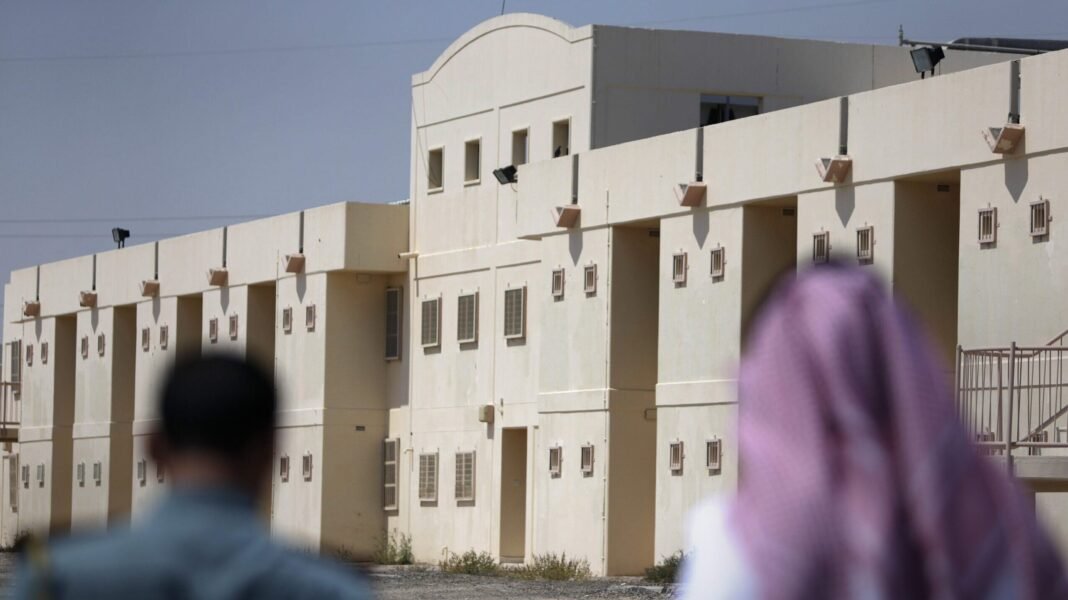Situated in the desolate heat and sand south-east of Abu Dhabi, a fortress-like compound buzzes with quiet intensity. Sweihan Jail is not frequently referenced in the same space as the UAE’s towering skyscrapers or luxurious resort-style living, yet it exerts a power over the lives of thousands of people, most of foreign nationality, who face the sharp edge of immigration law. Their stories can trickle out – of solitude and isolation, of lingering in relentless heat, of the regimented routine that wears the spirit down, and of occasional signs of hope in the form of rehabilitation. For expatriates, visitors, or workmen embroiled in visa issues or minor infringements, Sweihan Jail is, ironically, a sudden and surreal plunge into a neat world of logical precision and consequence. What summons people here, and what is actually in place when the gates close?
This article presents the essential contexts of Sweihan Jail (its history, daily experience, etc.) for readers to consider how Sweihan Jail fits into a bigger agenda of order and reform within the UAE.
A Brief History of Sweihan Jail
Sweihan Jail originated in the early 2000s as part of the UAE’s expanding network of jails in response to rapid population growth and the influx of migrant workers. Abu Dhabi was a rising global metropolis, inviting millions to work and live; however, this influx led to complications with immigration control and minor crime. Sweihan Jail was created to relieve crowded urban jails, but was unique, as it was opened to house individuals who were administratively detained, as opposed to those serving longer sentences.
In the years following, Sweihan has developed under the Federal Authority for Identity, Citizenship, Customs and Port Security (ICP) into an immigration detention center, and has marketed that purpose to the surrounding community. Sweihan Jail is not a high-level security jail for individuals convicted of serious charges; it is a facility that works to increase punishment for those accused of visa overstay, labor violations, or street-level infractions. Sweihan Jail detainees contribute toward clogging the immigration system, but for the most part, do not make international headlines about abuses. By the mid-2010s, reports indicate that Sweihan Jail’s average capacity was around 2,700 beds, standardized on the UAE’s complete ‘zero-tolerance’ policy toward residency offenses. Today, Sweihan Jail remains a regional cornerstone in Abu Dhabi’s correctional landscape that utilizes enforcers and oversight to marry old traditions with new processes.
Location and Purpose in the UAE’s Justice Web
Located sixty kilometers to the southeast of the busy center of Abu Dhabi, in an area called Al Ain, near the village of Sweihan, the prison is situated amidst vast dunes and many underpopulated villages. The fact that it is there is not an accident; the distance makes escape inconvenient and reduces visibility of operations. Roads led into the prison through checkpoints, which demonstrates a level of security that the United Arab Emirates adheres to through multiple layers of oversight and correction.
The interviews themselves suggest that Sweihan processes administrative immigration cases and houses people for relatively brief periods while they await deportation, fine payment, or residency. It is managed by the ICP, which is separate from police-managed jails or prisons, like Al Wathba or Al Ain. This is an important point, apparently, as the whole point of the interview is processing people as quickly as possible to affirm that the Emirates are a highly efficient culture. This makes sense, because the people at Sweihan are not housed for long periods of time, weeks to a few months, as opposed to the years of incarceration in criminal prison in balance. The fact that 90% of people living in the UAE are expats means there is a steady stream of people being processed at Sweihan for various other reasons, enforcing the rules of the UAE to maintain social stability, while driving economic stability by carrying on and sustaining compliance.
Who Ends Up Behind the Walls?
Sweihan’s demographic profile is dominated by foreigners, who currently comprise the majority of the population of approximately 2,000-2,500 at any time. South Asian, African, and Middle Eastern nationals are upfront among the foreign county nationals and often low-wage workers who got themselves in trouble with an employer or failed to renew their visa and did not leave the country. Tourists also in some cases find themselves on the way to Sweihan for violations like bounced checks or intoxication, two offenses that might be seen as minor in their home country but have some weight under UAE law.
Only very occasionally do they get petty criminals who may have a bounced check or committed some minor theft; however, Sweihan does not typically attract heavy hitters like drug lords, who are usually seen in the federal courts. Women and juveniles are assigned wings in accordance with the gender-segregated approach prevalent in the UAE culture. A former detainee in 2023 provided some insight into the heterogeneous population by recounting the story of a Ugandan security guard charged in a workplace incident, and who had virtually nothing in common with the mass of overstayed workers. The diversity alone speaks to the varied functions of the jail, especially at the county level, and addresses some on the unintended consequences of the UAE’s economy controlled by migrant populations.
Life Inside: Conditions and Facilities
Conditions at Sweihan reflect larger trends in UAE detention, operational yet harsh, particularly during the extreme summer heat. The cells are barebones: concrete bunks, shared bathroom facilities, and designed for temporary detention, with little in the way of comfort. During peak violation seasons, the cells become crowded, which can mean sleeping on floors or sharing thin foam mattresses.
Food is basic: rice, lentils, bread, and a source of protein served three times a day, with halal food for all employees. There is a nurse on-site for regular physical checkups and emergencies, but critics have pointed out a lack of mental health services and specialized doctor access. There is air conditioning, but when it breaks down, conditions deteriorate quickly. Staff members reported feeling exhausted from the heat, and other inmates complained of heat exhaustion. Hygiene is maintained through communal showers and sinks for tooth brushing, and even though they were generally clean, the arrangement led to frustration with the lack of privacy. Overall, facilities are constructed for safety and maintenance rather than comfort or luxury; there are barred windows and cages, with staff patrolling regularly to prevent staff from becoming overwhelmed by inmates.
A Day in the Life at Sweihan
Early mornings begin at around 5 a.m. with the sound of calls to prayer coming from all corners, reflecting its Muslim heritage in the UAE. Following breakfast, the daily headcount, and some outdoor access if the schedule allows, the hours turn into lockdown. During lockdown, there are opportunities to read the books that are smuggled in, talk quietly with someone else, or stare at the walls. In the afternoon, processing paperwork for administration, sketch interviews for deportation, or negotiation will be done about the fines you allegedly incurred.
In the evening, there will be another meal, and the lights will be out by 9 p.m. The rhythm of the day keeps you in check so you don’t get lost in the days to idleness, but boredom is also heightened by the rhythm. Those who exercise will do so in shifts, primarily walking around the secure area while others watch. Prayers in a group setting are an occasional break from the routine of some type of community. The routine is especially hard for many; days get long without any news from the outside world, and minor rules become major regrets.
Staying Connected: Visits and Communication
Family ties don’t snap entirely at Sweihan, but access demands planning. Visits run mornings from 8 a.m. to 2 p.m., Sunday through Thursday, skipping Fridays for rest. Relatives need permits via the Tamm app or ICP offices, proving ties and clearing security. Sessions last 30-60 minutes in supervised rooms, with glass partitions standard for immigration cases.
Phone calls and letters bridge gaps, with embassies facilitating consular check-ins for nationals. Funds can flow in weekly, up to 1,000 AED total, for canteen buys like extra food or toiletries. Yet, remote location and bureaucracy often strain these links, leaving detainees feeling adrift.
Rehabilitation and Second Chances
Prisons in the United Arab Emirates, including Sweihan, place a strong emphasis on reform over punishment. These initiatives are designed to focus on skills acquisition: vocational training in areas like carpentry or basics of information technology, supplemented by classes for non-Arabic forfeiture and literacy. Religious counseling is framed around Islamic principles of redemption, while counseling, as well as drug addiction and anger-oriented counseling, addresses the causes of the underlying behavior, the cause of the law.
Within a one-month time frame, the detainees who take part can leave with a certificate to assist with their reentry into employment in another jurisdiction. In those instances where the primary cause of stay was immigration related, the emphasis of legal education and development consisted of teaching the laws of the United Arab Emirates and avoiding future criminal behaviour. Roughly 80% of inmates qualifying for programs in prison will still qualify for programs, and this opens up an ongoing cycle of correction as opposed to a continuing cycle of crime.
Recent Reforms and Ongoing Challenges
The UAE has rolled out tweaks to ease Sweihan’s pressures. Electronic tagging is now an alternative to short sentences for minor cases, cutting bed needs. Virtual courts speed hearings, and expanded rehab budgets address overcrowding. Human rights monitors praise these steps, though gaps linger: better mental health resources and consistent AC top wish lists.
Challenges persist, diplomatic reports flag retaliation fears for complaints and uneven sunlight access. As Abu Dhabi eyes 2030 sustainability goals, expect more tech integrations, like AI-monitored health checks, to humanize the harsh edges.
Wrapping Up
Sweihan Jail embodies the UAE’s tightrope walk: enforcing ironclad rules to safeguard a thriving society while inching toward compassionate corrections. For the foreigners, it holds that it’s a tough teacher, highlighting how small slips in a foreign land can lead to big disruptions. Yet, with reforms gaining traction, the facility signals a maturing system, one that bets on redemption over ruin. Whether you’re an expat eyeing a UAE move or just curious about hidden corners of justice, Sweihan reminds us: respect the lines, and the desert stays welcoming.





